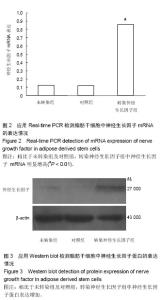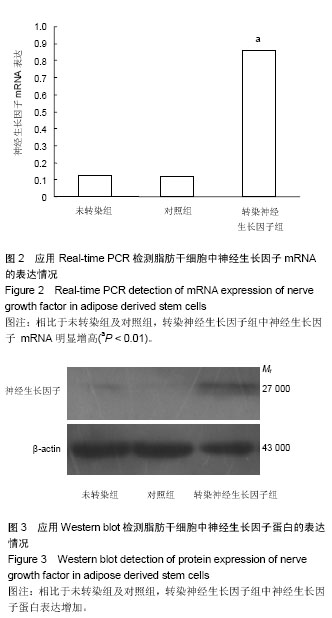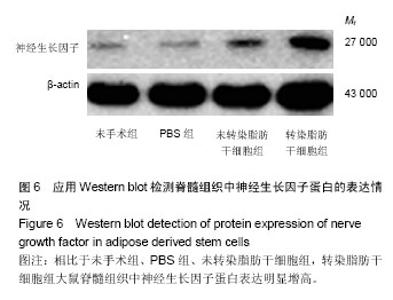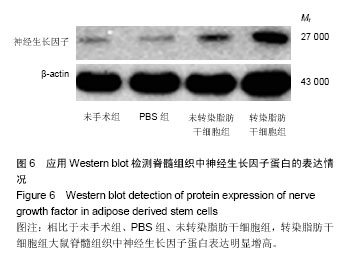Chinese Journal of Tissue Engineering Research ›› 2015, Vol. 19 ›› Issue (14): 2224-2229.doi: 10.3969/j.issn.2095-4344.2015.14.016
Previous Articles Next Articles
Nerve growth factor-modified adipose derived stem cells for repair of spinal cord injury
Wang Yong, Zhao Wei, Feng Jian-zhou, Chen Xiao-chun
- The 4th Department of Orthopedics, the Central Hospital Affiliated to Shenyang Medical College, Shenyang 110024, Liaoning Province, China
-
Revised:2015-04-11Online:2015-04-02Published:2015-04-02 -
Contact:Chen Xiao-chun, Master, Chief physician, Professor, the 4th Department of Orthopedics, the Central Hospital Affiliated to Shenyang Medical College, Shenyang 110024, Liaoning Province, China -
About author:Wang Yong, M.D., Attending physician, Lecturer, the 4th Department of Orthopedics, the Central Hospital Affiliated to Shenyang Medical College, Shenyang 110024, Liaoning Province, China -
Supported by:the Education Fund Item of Liaoning Province, No. L2014418; General Science Foundation of Shenyang Medical College, No. 20121008, 20132041; the Youth Fund of Shenyang Health Department
CLC Number:
Cite this article
Wang Yong, Zhao Wei, Feng Jian-zhou, Chen Xiao-chun. Nerve growth factor-modified adipose derived stem cells for repair of spinal cord injury [J]. Chinese Journal of Tissue Engineering Research, 2015, 19(14): 2224-2229.
share this article
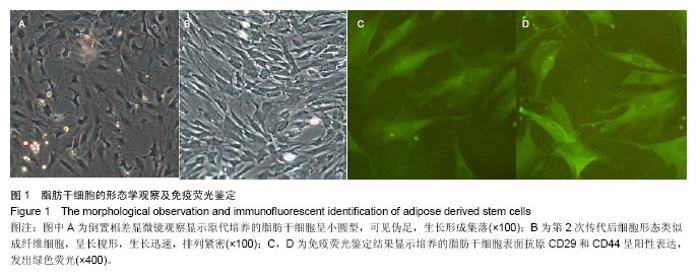
2.1 脂肪干细胞的形态学观察及免疫荧光鉴定 原代培养24 h即可见细胞贴壁,外形为类小圆型,呈团簇状生长,形成集落。3 d左右细胞融合超过80%时传代,传代后细胞生长速度明显加快,形态较均一,呈长梭形,排列紧密,类似成纤维细胞(图1A,B)。免疫荧光法检测细胞表面抗原CD29和CD44呈阳性表达,证实为干细胞来源(见图1C,D)。 2.2 脂质体介导的神经生长因子质粒转染结果 应用Real-time PCR和Western blot分别从mRNA和蛋白水平检测转染后脂肪干细胞中神经生长因子的表达情况,结果显示,相比于未转染组和对照组,转染神经生长因子组的脂肪干细胞中神经生长因子的mRNA和蛋白表达水平明显升高,证实转染获得了成功(图2,3)。"
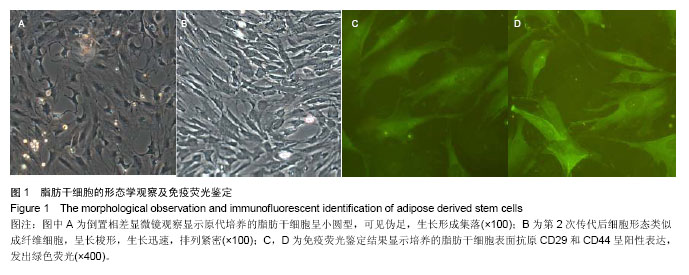
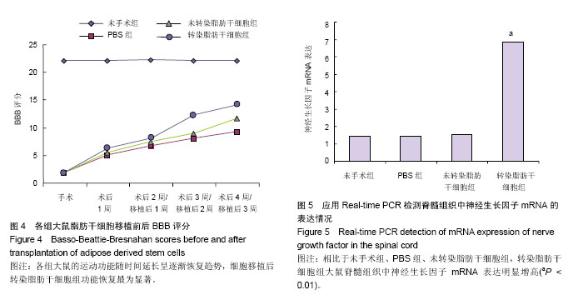
2.3 BBB评分结果 未手术组在各时间点BBB评分无变化,而相比于未手术组,PBS组、未转染脂肪干细胞组及转染脂肪干细胞组大鼠BBB评分在脊髓损伤术后最低,此3组间差异无显著性意义(P > 0.05)。 随着时间的延长,大鼠后肢的运动功能逐渐恢复;在移植细胞前及移植细胞后1周,大鼠后肢运动功能恢复差异无显著性意义(P > 0.05);而在移植后2周及3周,转染脂肪干细胞组大鼠的后肢运动功能恢复显著优于PBS组、未转染脂肪干细胞组,差异有非常显著性意义(P < 0.01),见图4。 2.4 脂肪干细胞移植3周后损伤节段脊髓中神经生长因子的表达 脂肪干细胞移植后3周,切取脊髓损伤上下各 1 cm区域脊髓组织行Real-time PCR和Western blot检测神经生长因子的表达情况。结果显示,相比于未手术组、PBS组、未转染脂肪干细胞组,转染脂肪干细胞组大鼠脊髓中神经生长因子mRNA和蛋白表达水平明显升高。据此可以判断,移植神经生长因子修饰后的脂肪干细胞可增加相应节段脊髓内神经生长因子的表达,而这种神经生长因子表达的增加与脊髓功能恢复有关或者说呈正相关(图5和图6)。"
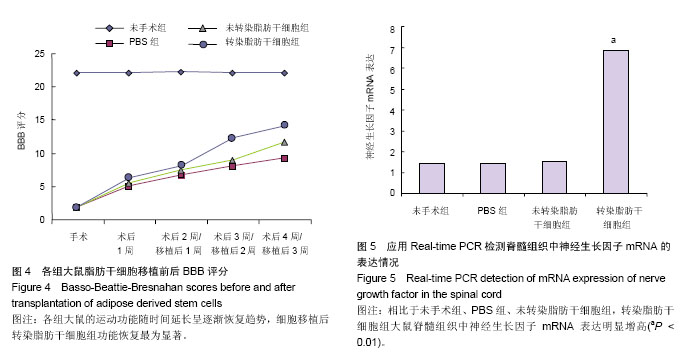
| [1] Cui X, Chen L, Ren Y, et al. Genetic modification of mesenchymal stem cells in spinal cord injury repair strategies. Biosci Trends. 2013;7(5):202-208. [2] Aloe L, Bianchi P, De Bellis A, et al. Intranasal nerve growth factor bypasses the blood-brain barrier and affects spinal cord neurons in spinal cord injury. Neural Regen Res. 2014;9(10): 1025-1030. [3] Zhang H, Wu F, Kong X, et al. Nerve growth factor improves functional recovery by inhibiting endoplasmic reticulum stress-induced neuronal apoptosis in rats with spinal cord injury. J Transl Med. 2014;12:130. [4] Zuk PA, Zhu M, Mizuno H, et al. Multilineage cells from human adipose tissue: implications for cell-based therapies. Tissue Eng. 2001;7(2):211-228. [5] 徐帆,陈建敏,张晓.脊髓损伤动物模型的制备及神经功能评价[J]. 创伤外科杂志,2007,9(1):91-93. [6] Basso DM, Beattie MS, Bresnahan JC. Graded histological and locomotor outcomes after spinal cord contusion using the NYU weight-drop device versus transection. Exp Neurol. 1996; 139(2):244-256. [7] 彭忠勇,陈志斌,修波,等.嗅鞘细胞移植联合督脉电针对脊髓损伤大鼠脊髓诱发电位的影响[J].中国组织工程研究与临床康复, 2009,13(23):4426-4432. [8] Thuret S, Moon LD, Gage FH. Therapeutic interventions after spinal cord injury. Nat Rev Neurosci. 2006;7(8):628-643. [9] Ting LH, Chiel HJ, Trumbower RD, et al. Neuromechanical Principles Underlying Movement Modularity and Their Implications for Rehabilitation. Neuron. 2015;86(1):38-54. [10] Tanhoffer RA, Tanhoffer AI, Raymond J, et al. Energy expenditure in individuals with spinal cord injury quantified by doubly labeled water and a multi-sensor armband. J Phys Act Health. 2015;12(2):163-170. [11] Cardenas DD, Emir B, Parsons B.Examining the Time to Therapeutic Effect of Pregabalin in Spinal Cord Injury Patients With Neuropathic Pain.Clin Ther. 2015. [Epub ahead of print] [12] Nicaise C, Mitrecic D, Falnikar A, et al. Transplantation of stem cell-derived astrocytes for the treatment of amyotrophic lateral sclerosis and spinal cord injury. World J Stem Cells. 2015; 7(2):380-398. [13] Watanabe S, Uchida K, Nakajima H, et al. Early Transplantation of Mesenchymal Stem Cells after Spinal Cord Injury Relieves Pain Hypersensitivity Through Suppression of Pain-Related Signaling Cascades and Reduced Inflammatory Cell Recruitment.Stem Cells. 2015 Mar 24. doi: 10.1002/stem.2006. [Epub ahead of print] [14] Garbossa D, Boido M, Fontanella M, et al. Recent therapeutic strategies for spinal cord injury treatment: possible role of stem cells. Neurosurg Rev. 2012;35(3):293-311. [15] Mothe AJ, Tator CH. Advances in stem cell therapy for spinal cord injury. J Clin Invest. 2012;122(11):3824-3834. [16] Tsuji O, Miura K, Okada Y, et al. Therapeutic potential of appropriately evaluated safe-induced pluripotent stem cells for spinal cord injury. Proc Natl Acad Sci U S A. 2010;107(28): 12704-12709. [17] Wang D, Liang J, Zhang J, et al. Mild hypothermia combined with a scaffold of NgR-silenced neural stem cells/Schwann cells to treat spinal cord injury. Neural Regen Res. 2014;9(24): 2189-2196. [18] Minteer DM, Marra KG, Rubin JP. Adipose Stem Cells: Biology, Safety, Regulation, and Regenerative Potential. Clin Plast Surg. 2015;42(2):169-179. [19] Kapur SK, Dos-Anjos Vilaboa S, Llull R, et al. Adipose Tissue and Stem/Progenitor Cells: Discovery and Development. Clin Plast Surg. 2015;42(2):155-167. [20] Kingham PJ, Reid AJ, Wiberg M. Adipose-Derived Stem Cells for Nerve Repair: Hype or Reality. Cells Tissues Organs. 2015 Mar 21. [Epub ahead of print] [21] Azari MF, Mathias L, Ozturk E, et al. Mesenchymal stem cells for treatment of CNS injury. Curr Neuropharmacol. 2010;8(4): 316-323. [22] Mufti RE, Sarker K, Jin Y, et al. Thrombin enhances NGF-mediated neurite extension via increased and sustained activation of p44/42 MAPK and p38 MAPK. PLoS One. 2014; 9(7):e103530. [23] Lin CL, Heron P, Hamann SR, et al. Functional distinction between NGF-mediated plasticity and regeneration of nociceptive axons within the spinal cord. Neuroscience. 2014;272:76-87. [24] Grill RJ, Blesch A, Tuszynski MH. Robust growth of chronically injured spinal cord axons induced by grafts of genetically modified NGF-secreting cells. Exp Neurol. 1997; 148(2):444-452. [25] Shi B, Ding J, Liu Y, et al. ERK1/2 pathway-mediated differentiation of IGF-1-transfected spinal cord-derived neural stem cells into oligodendrocytes. PLoS One. 2014;9(8): e106038. [26] Wang LJ, Zhang RP, Li JD. Transplantation of neurotrophin-3-expressing bone mesenchymal stem cells improves recovery in a rat model of spinal cord injury. Acta Neurochir (Wien). 2014;156(7):1409-1418. [27] Zhang YJ, Zhang W, Lin CG, et al. Neurotrophin-3 gene modified mesenchymal stem cells promote remyelination and functional recovery in the demyelinated spinal cord of rats. J Neurol Sci. 2012;313(1-2):64-74. [28] Kumagai G, Tsoulfas P, Toh S, et al. Genetically modified mesenchymal stem cells (MSCs) promote axonal regeneration and prevent hypersensitivity after spinal cord injury. Exp Neurol. 2013;248:369-380. [29] Sasaki M, Radtke C, Tan AM, et al. BDNF-hypersecreting human mesenchymal stem cells promote functional recovery, axonal sprouting, and protection of corticospinal neurons after spinal cord injury. J Neurosci. 2009;29(47):14932-14941. [30] Schor NF. The p75 neurotrophin receptor in human development and disease. Prog Neurobiol. 2005;77(3): 201-214. [31] Ginty DD, Segal RA. Retrograde neurotrophin signaling: Trk-ing along the axon. Curr Opin Neurobiol. 2002;12(3): 268-274. |
| [1] | Wang Jian-ji, Yang Long, Li Jing, Sun Qi, Zuo Wei-min, Ren Qi-feng, Sun Yu, Wu Zhan-yu, Zou Qiang, Ma Min-xian, Ye Chuan. Development and application of special-purpose grafter by femoral head decompression combined with bone marrow mesenchymal stem cells transplantation based on three-dimensional printing technology [J]. Chinese Journal of Tissue Engineering Research, 2016, 20(44): 6636-6642. |
| [2] | Yu Yu-qin, Hu Nian-chun, Duan Ji-an, Li Da-peng, Liu Chang. Neuroprotective effects of sufentanil preconditioning on spinal cord injury in mouse models [J]. Chinese Journal of Tissue Engineering Research, 2016, 20(40): 5966-5972. |
| [3] | Fan Xu-hui, Yang Bo, Hu Xiang, Guan Fang-xia. Reactive hyperplasia of glial cells induced by spinal cord injury in a rat model [J]. Chinese Journal of Tissue Engineering Research, 2016, 20(40): 6001-6006. |
| [4] | Zhou Chang-yan, Zhou Qing-huan, Bian Jing, Chen Ke, Chen Wen. Bone marrow mesenchymal stem cells combined with calcium phosphate cement to repair articular cartilage defects in rabbits [J]. Chinese Journal of Tissue Engineering Research, 2015, 19(8): 1195-1199. |
| [5] | Xu Xiang, Yin He-ping. Platelet-rich plasma accelerates the proliferation of bone marrow mesenchymal stem cells [J]. Chinese Journal of Tissue Engineering Research, 2015, 19(14): 2144-2148. |
| [6] | Ma Fa-ku, Wang Huan, Liu Bin, Yang Yan-li, Su Qin-jun, Qian Zhen, Dong Liang. Expression of CD44+/C-myc+ cancer stem cells and its relationship with the prognosis of patients in colorectal tumors [J]. Chinese Journal of Tissue Engineering Research, 2015, 19(14): 2161-2166. |
| [7] |
Chen Ping, Wang Jian.
Enrichment of lung cancer stem cells and expression of related markers
[J]. Chinese Journal of Tissue Engineering Research, 2015, 19(14): 2167-2171.
|
| [8] |
Liu Yu-liang, Li Jun, He Yu-qin, Zhuo Feng, Wei Kai-bin.
Transplantation of human umbilical cord derived-mesenchymal stem cells by different ways for the treatment of spinal cord injury
|
| [9] | Fan Zhi-gang, Fan Hong-liang. Oxidative stress response in diabetic nephropathy rats following injection of embryonic stem cells via the tail vein [J]. Chinese Journal of Tissue Engineering Research, 2015, 19(14): 2199-2204. |
| [10] | Wang Guo-xi, Wang Guo-qian, Zhang Shu-quan. Hyperbaric oxygen combined with Schwann cells transplantation for spinal cord injury in rats: electrophysiological and functional changes of the hind limbs [J]. Chinese Journal of Tissue Engineering Research, 2015, 19(14): 2205-2210. |
| [11] | Sha Wen-qiong, She Rui-lian, Wang Zi-neng, Ke Ru. Ultrastructure and phagocytotic function of human placental mesenchymal stem cells [J]. Chinese Journal of Tissue Engineering Research, 2015, 19(14): 2230-2235. |
| [12] | Du Qing-hua, Cao Jun-kai, Dong Xi-xi, E Ling-ling, Wei Li-jun. Osteogenic differentiation of pluripotent stem cells induced by akermanite extracts [J]. Chinese Journal of Tissue Engineering Research, 2015, 19(14): 2236-2242. |
| [13] | Wu Yan, Huang Lan . Bone morphogenetic protein 9-induced osteogenic differentiation of dental follicle cells in vitro [J]. Chinese Journal of Tissue Engineering Research, 2015, 19(14): 2255-2260. |
| [14] | Rao Li-jia, Li Qi-meng, Li Jin-ling, Xu Qiong. Expression pattern of ten-eleven translocation family during differentiation of human dental pulp cells [J]. Chinese Journal of Tissue Engineering Research, 2015, 19(14): 2261-2266. |
| [15] | Gao Zhuo-yue, Liu Yong-qi, He Jian-xin, Wu Zhi-wei, Luo Ya-li, Su Yun, Zhang Li-ying, Zhang Qi, Wu You-ming, Zhou Ni-na. Regulatory effects of warming yang and invigorating qi treatment on the inflammatory balance and genetic stability of bone marrow mesenchymal stem cells under tumor microenvironment [J]. Chinese Journal of Tissue Engineering Research, 2015, 19(14): 2267-2272. |
| Viewed | ||||||
|
Full text |
|
|||||
|
Abstract |
|
|||||
